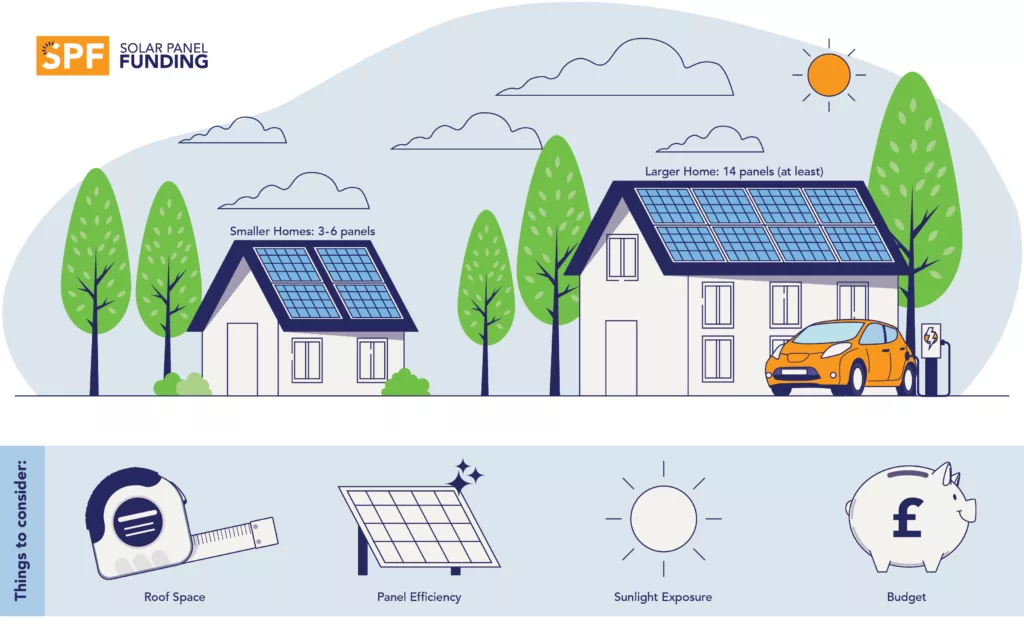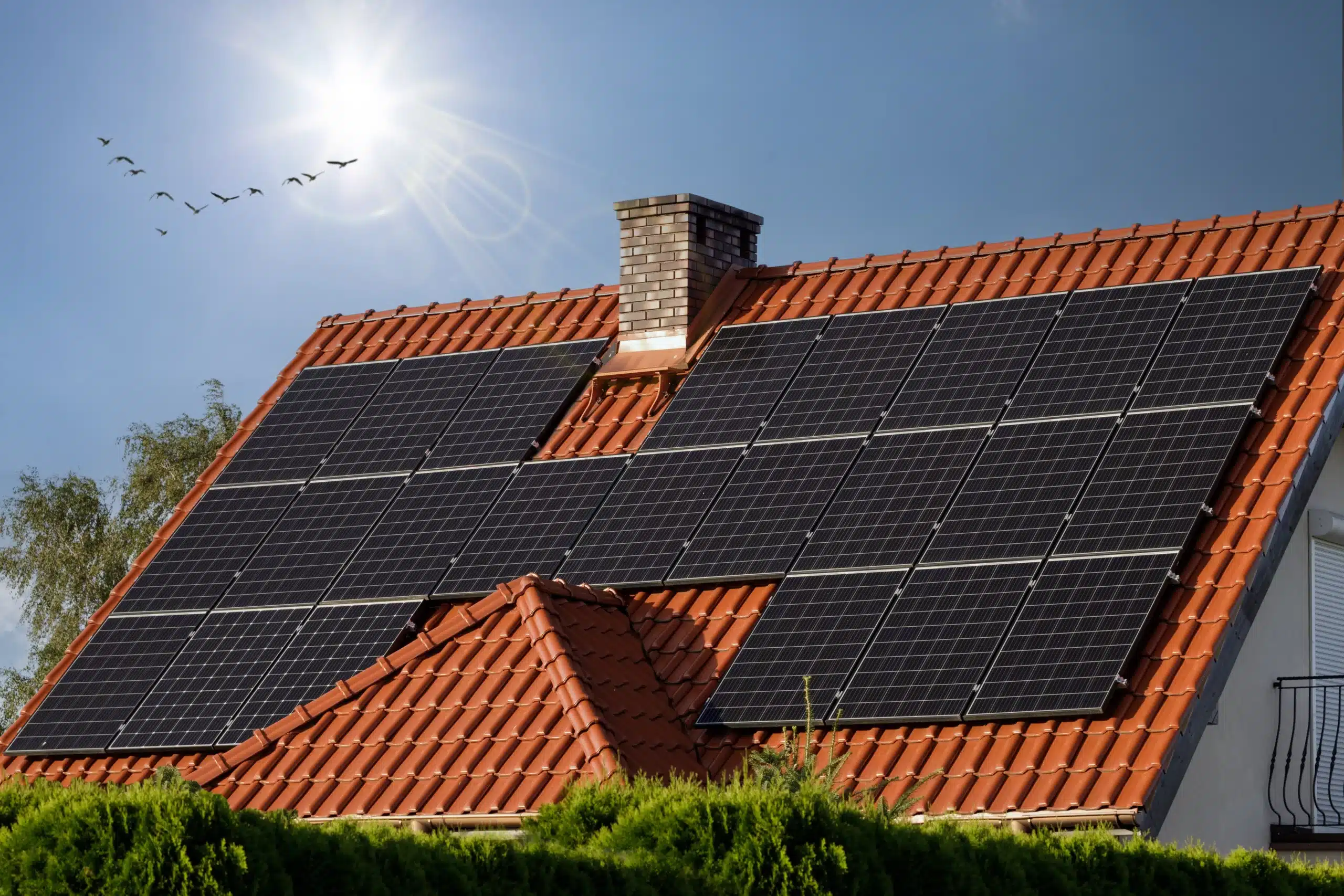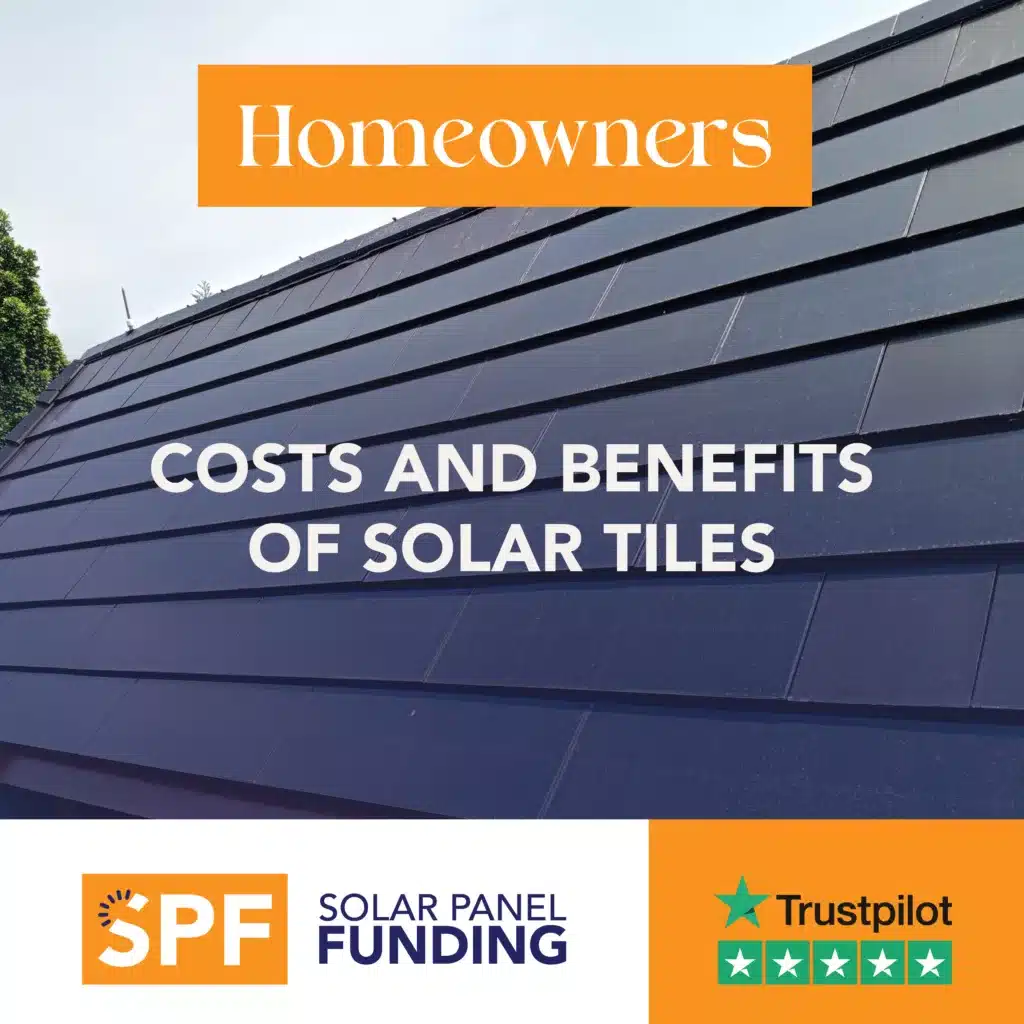
- How Do Solar Panels Work?
- How Many Solar Panels Do You Need?
- Is Your Home Suitable for Solar Panels?
- Factors That Affect Solar Panel Efficiency
- How Much Do Solar Panels Cost?
- Can Solar Panels Be Financed?
- Reduce the Cost of Solar Panels with UK Grants and Incentives
- How Much Money Could You Earn with Solar Panels?
- How Much Money Could You Save with Solar Panels?
- When Will You Break Even on Your Solar Panels?
- What Affects Solar Panel Payback Time?
- Are Solar Panels Covered by Home Insurance?
- Do Solar Panels Increase Home Value?
- Are Solar Panel Wort It? Pros and Cons of Getting Solar Panels
- Frequently Asked Questions
Pros
✅ Lower electricity bills
✅ Earn money back
✅ More energy independence
✅ Low maintenance
✅ Lower carbon emissions
Cons
❌ High upfront cost
❌ Not every roof is suitable
❌ Less efficient at night

Ready to buy?
Skip the hassle and get free no obligation quotes from local installers. Fill out our 30-second form by clicking the button below.
Solar panels cut electricity costs, reduce carbon emissions, and even earn you money. But are they worth it?
The short answer is yes. A typical solar panel system can save up to £1,020 a year and cut nearly a tonne of carbon emissions. No wonder 1.5 million UK homes already have them, according to MCS data. Even on gloomy days, they still generate electricity.
However, solar panels cost around £7,000 on average, so it is important to know if the savings outweigh the costs. Generating free electricity from the sun sounds appealing, but does the financial return justify the upfront cost?
In this guide, we break down everything you need to know, including costs, savings, government incentives, and whether solar panels make financial sense for you.
How Do Solar Panels Work?
Solar panels convert sunlight into electricity using a process called photovoltaics (PV). They contain electrons that start moving when exposed to direct sunlight. This movement creates an electric current, which is then converted into usable electricity for your home.
The electricity flows through wires from the solar panels and powers your appliances, lights, and even electric vehicles. Any unused electricity can be sent back to the grid, and energy suppliers will pay you for it through the Smart Export Guarantee.
There are different types of solar panels, but the most common in the UK are monocrystalline and polycrystalline panels.
Monocrystalline panels cost about 20% more than polycrystalline panels but are the most efficient for homes.
Polycrystalline panels are cheaper but about one-third less efficient. You may need more panels to produce the same amount of power.

How Many Solar Panels Do You Need?
| Roof size | System size | Solar Panels Needed (450W) |
|---|---|---|
| Small; 1-2 bedrooms | 2 kW solar system | 5 |
| Small; 1-2 bedrooms | 3 kW solar system | 6 |
| Medium; 2-3 bedrooms | 4 kW solar system | 8 |
| Medium; 2-3 bedrooms | 5 kW solar system | 12 |
| Large; 4-5 bedrooms | 6 kW solar system | 14 |
| Large; 6+ bedrooms | 10 kW solar system | 20+ |
The number of solar panels you need depends on how much electricity your home uses. Larger homes typically require more panels, while smaller homes with lower energy consumption need fewer.
A small home may need between 3 and 6 panels, while a larger home may require at least 14 panels.
However, other factors also affect how many panels you need:
Roof space: The size of your roof determines how many panels can be installed.
Panel efficiency: More efficient panels generate more electricity, meaning you may need fewer to meet your energy needs.
Sunlight exposure: Homes that get less sunlight need more panels to generate the same amount of electricity. Shade from trees or buildings can also reduce efficiency. Also, some properties may not be suitable for solar panels at all.
Budget: The number of panels you can install will also depend on what you can afford.
Is Your Home Suitable for Solar Panels?
| Roof size | System size | Solar Panels Needed (450W) | Yearly Energy Output |
|---|---|---|---|
| Small; 1-2 bedrooms | 2 kW solar system | 5 | 1,700 kWh |
| Small; 1-2 bedrooms | 3 kW solar system | 6 | 2,550 kWh |
| Medium; 2-3 bedrooms | 4 kW solar system | 8 | 3,400 kWh |
| Medium; 2-3 bedrooms | 5 kW solar system | 12 | 4,250 kWh |
| Large; 4-5 bedrooms | 6 kW solar system | 14 | 5,100 kWh |
| Large; 6+ bedrooms | 10 kW solar system | 20+ | 8,500 kWh |
Your home is suitable for solar panels if it meets these key requirements:
Adequate roof space: Each panel takes up around 2 square metres. If you need 20 panels to generate 8 kWh per day, you will require 40 square metres of roof space.
Space for an inverter: Solar panels need an inverter to convert sunlight into electricity. The inverter is about the size of a microwave and usually fits in the attic or loft.
Strong roof: Most roofs can support solar panels, but it is worth checking the structural integrity. If your roof is less than 15 years old, it should be strong enough.
It’s worth noting that solar panels are usually classed as “permitted development” in England and Wales, meaning no approval is required. The exceptions are listed buildings and conservation areas, where council approval may be needed.
As of December 2023, homes with flat roofs can also install panels without planning permission.
Factors That Affect Solar Panel Efficiency
Roof direction and angle: Solar panels work best on a south-facing roof at a 35-degree angle. They can still generate decent power on an east- or west-facing roof, and they’ll work at angles between 10 and 60 degrees.
Most houses fit this description, which is lucky because changing your roof’s angle is a hassle and usually requires a complex frame system and planning permission.
Shading: Your roof should be unshaded between 10am and 4pm to get the most power from your panels. A bit of shade early in the morning or late in the afternoon is fine, but trees or buildings blocking sunlight during peak hours will reduce efficiency.
Time of year and weather: Solar panels generate more power in summer when the days are longer and there are more sunshine hours. But if the temperature goes above 25°C, they can lose a bit of efficiency.
Solar panels still work on cloudy days but expect 25-50% less power than on a sunny day.
Dirt and debris: If your panels are covered in leaves, dust, or bird droppings, they won’t generate as much power. Manufacturers recommend cleaning them twice a year, but if that’s not doable, once every two years still helps.
The safest way to clean solar panels is with a soft sponge and soapy water.
Roof condition: A damaged roof can complicate installation. If your tiles are old or in poor condition, it may be worth replacing them before adding solar panels.
How Much Do Solar Panels Cost?
| Roof size | System size | Solar Panels Needed (450W) | Estimated Costs Incl. Installation |
|---|---|---|---|
| Small; 1-2 bedrooms | 2 kW solar system | 5 | £2,500 – £3,500 |
| Small; 1-2 bedrooms | 3 kW solar system | 6 | £4,500 – £5,500 |
| Medium; 2-3 bedrooms | 4 kW solar system | 8 | £5,000 – £7,000 |
| Medium; 2-3 bedrooms | 5 kW solar system | 12 | £7,500 – £8,500 |
| Large; 4-5 bedrooms | 6 kW solar system | 14 | £9,500 – £10,500 |
| Large; 6+ bedrooms | 10 kW solar system | 20+ | £10,000 – £11,000 |
A 4kW solar panel system costs £5,000 to £7,000, which is enough to power the average 2-3 bedroom home with 2,700kWh of electricity a year.
The total cost depends on a few things.
A bigger system costs more, and if your roof is tricky to access, expect higher installation fees.
Solar tiles are pricier than standard panels, and if you want the panels built into the roof, that will push up the price too. If your roof needs work anyway, getting the panels installed at the same time could save you money in the long run.
You might cut costs if you already have scaffolding up for roof repairs or if you’re fitting panels onto a new build.
Ground-mounted solar panel systems are harder to price, since costs vary based on the type of mounting frame and how far the system is from your home.
Can Solar Panels Be Financed?
| Roof size | System size | Estimated Costs | Monthly Payments |
|---|---|---|---|
| Small; 1-2 bedrooms | 3 kW solar system | £4,500 – £5,500 | £38 – £62 |
| Medium; 2-3 bedrooms | 4 kW solar system | £5,000 – £7,000 | £50 – £87 |
| Medium; 2-3 bedrooms | 5 kW solar system | £7,500 – £8,500 | £62 – £100 |
If you can’t pay for solar panels upfront, some companies offer financing and subscription options. Before signing up, check how this could affect your mortgage and what happens if you sell your home.
How solar panel financing affects mortgages
Most lenders won’t refuse a mortgage just because you finance solar panels, but they may factor the payments into affordability checks. If you already have a mortgage, it’s best to check with your lender before signing up.
Some financing options restrict what you can do with your roof, so adding skylights or changing roofing materials may not be possible.
Selling a home with a long-term solar contract can also be tricky, as buyers might need to take over the agreement or negotiate an early payout.
Types of solar panel financing
There are two main ways to finance solar panels. One option allows you to own them while paying in instalments, while the other is a rental agreement where you lease the panels for a fixed period.
You OWN the solar panels: With this option, you pay for the panels over a fixed period (usually around 20 years) instead of paying upfront. Monthly payments typically cover the cost of the panels, installation, and maintenance.
Since you own the panels from day one, you can sell any excess electricity back to the grid through the Smart Export Guarantee (SEG).
If you move home, you can pay off the balance early without penalties, though this could still be a large amount. The new homeowner may be able to take over the contract, but this depends on the lender and buyer agreement.
You RENT the solar panels: With a solar panel lease, you rent the panels from a third party for a fixed period. The provider retains ownership, meaning the panels are not part of your property.
If you sell your home, the buyer may need to agree to take over the lease, which can complicate the sale.
Under English property law, any installed panels automatically belong to the homeowner unless a lease agreement is in place, so rental plans require a formal roof lease.
Reduce the Cost of Solar Panels with UK Grants and Incentives
There are several funding options available to help UK homeowners reduce the cost of solar panels, with some offering free installations or financial support for eligible households.
Below are the available grants and incentives as of February 2025.
SPF Grant
The Solar Panel Funding (SPF) Grant is privately funded by Solar Panel Funding’s own profits and is not a government grant. It covers the full cost of solar panels for eligible homeowners.
Grants are available on a first-come, first-served basis, and the number of installations awarded each year depends on how many people book a no-obligation survey.
Solar Panel Funding sets its own eligibility criteria and can change them at any time. If you qualify, you’ll receive up to three phone calls, so it’s important to answer.
Even if you don’t meet the requirements, booking a survey still helps fight fuel poverty, as it supports our ability to install free systems for those in need.
To check if you qualify, apply for the SPF Grant today by booking a free, no-obligation survey.
Energy Company Obligation (ECO4) scheme
The ECO4 scheme runs until 2026 and provides free or partially funded solar panels to low-income households. Your eligibility depends on an assessment of your home’s energy efficiency.
0% VAT on solar panel installations
All solar panel installations qualify for 0% VAT until 2027. This reduces costs by up to £2,850 for a 4kW system with a battery.
Smart Export Guarantee (SEG)
The Smart Export Guarantee (SEG) lets you sell extra electricity back to the grid. It’s not a grant, but it helps reduce energy costs.
Warm Homes Plan
The Warm Homes Plan starts in January 2025 and runs until 2028. It provides up to £30,000 for solar panel installations and home energy upgrades.
This funding is available for social housing residents, low-income households, and renters looking to cut energy bills.
How Much Money Could You Earn with Solar Panels?
Solar panels can earn you money. If you generate more electricity than you use, you can sell the extra back to the grid through the Smart Export Guarantee (SEG).
The amount you earn depends on your supplier’s tariff, which can range from 1p to 40p per kWh. Some, like Octopus Outgoing Agile, sometimes pay more, but their rates change every 30 minutes.
A typical 3 bedroom home with a 4.5kWp system could earn around £470 a year at 15p per kWh. Combined with energy bill savings, this could cut electricity costs by 70%, compared to 49% without SEG payments.
SEG rates aren’t fixed, so suppliers can change them at any time. You don’t have to use the same supplier for your SEG and energy tariff, but some companies offer better rates to existing customers.
To qualify for SEG payments, you need MCS-certified solar panels (5MW or less) and a smart meter that tracks exported electricity. If your meter isn’t compatible, your SEG provider can install a new one.
Solar thermal panels don’t qualify, as they only heat water, not generate electricity.
Applying is simple. You just need to fill out an application on your supplier’s website. You’ll need your MCS certificate and an up-to-date meter reading. Once approved, you’ll start getting paid for the electricity you don’t use.
How Much Money Could You Save with Solar Panels?
Buying electricity from the grid is more expensive than ever, so switching to solar power saves more now than it did a few years ago.
A typical 3 bedroom home with a 4.5kWp system could cut electricity bills by around £260 a year, compared to £773 without solar (almost 70% saving). As grid prices keep rising, your savings will only increase.
The biggest factors affecting savings are system size, energy use, and whether you’re home during the day to use the electricity your panels generate.
Where you live also matters. Homes in London and the south typically save 6% more than the national average, while homes in Scotland save 2% less due to shorter daylight hours.
The more electricity you use while the sun is shining, the more you save. However, if you don’t have a solar battery and mainly use electricity at night, you won’t save as much since you’ll still need to buy energy from the grid.
Having smart controls can help by automatically running washing machines, dishwashers, and EV chargers when your solar panels are generating power to make sure you use as much free electricity as possible.
Increasing solar savings with energy tariffs
Choosing the right energy tariff can push savings even further. Some tariffs let you buy energy when it’s cheapest and sell when it’s most valuable.
For example, Octopus Flux adjusts electricity rates throughout the day. The cheapest electricity is available between 2 am and 5 am, which is ideal for charging a battery. The best time to sell excess electricity back to the grid is between 4 pm and 7 pm, when demand is highest.
The import prices are 14.47p per kWh off-peak, 24.5p per kWh during the day, and 34.3p per kWh at peak times. The export prices are 4.6p per kWh off-peak, 13.03p per kWh during the day, and 26.0p per kWh at peak times.
Intelligent Octopus Flux manages battery charging and exporting for you. The system automatically charges when prices are low and sells energy when prices are high, so you don’t have to monitor rates yourself.
This tariff has just two pricing periods: 22.05p per kWh off-peak (7 pm to 4 pm) and 29.4p per kWh peak (4 pm to 7 pm).
Intelligent Octopus Go is a smart option for electric vehicle (EV) owners. It offers cheap off-peak electricity at around 7p per kWh, which is perfect for charging an EV or home battery overnight.
When paired with Octopus Outgoing Fixed, homeowners can buy energy cheaply and sell excess solar power back to the grid for a higher rate (15p per kWh).
Increasing savings with solar batteries
Using solar energy directly is more profitable than selling it through the Smart Export Guarantee (SEG). That’s where solar batteries come in.
A solar battery lets you store extra electricity instead of sending it to the grid. This means you use more of your own energy, cutting bills even further.
On average, a solar battery increases self-consumption by 30%, which saves the typical 3-bedroom home an extra £132 a year.
Are solar batteries worth it?
The benefits of a solar battery go beyond savings. A battery reduces your greenhouse gas emissions by 18 tonnes and makes you less dependent on the grid.
Without a battery, you can only use solar power as it’s generated. With one, you can store excess energy to use at night or during power outages.
If your household uses a lot of electricity in the evenings, pairing solar panels with a battery may be worth it.

When Will You Break Even on Your Solar Panels?
A 4.5kWp solar panel system costs around £7,500 and typically takes 10 to 15 years to pay for itself through energy savings and Smart Export Guarantee (SEG) payments.
The exact time depends on your electricity use, when you use it, the price of electricity, whether you have solar batteries, and how much you earn from exporting excess energy.
Most solar panels last 25 years or more, so after breaking even, you’ll be making pure savings for over a decade. Over 25 years, you could save up to £16,750, with a return on investment of £11,000 to £12,000.
What Affects Solar Panel Payback Time?
How efficient your panels are: Higher efficiency panels generate more power, so you rely less on the grid and save money faster. Monocrystalline panels tend to be the best choice for home use.
How much energy you use: If you use a lot of electricity, you’ll break even faster because more of your energy comes from the sun. The average UK home uses 2,700kWh per year, but high-energy users see quicker savings.
How much your system costs: A 4kW system for a three-bedroom home costs £5,000 to £7,000. If you go for larger systems, integrated panels, or complex installations, the payback time will be longer.
Whether you earn money back: The Smart Export Guarantee (SEG) lets you sell excess electricity back to the grid. The higher the SEG tariff, the faster you’ll break even.
If you have a solar battery: A battery helps you use more of your own energy, but it adds to the upfront cost (around £4,500). It delays the payback time, but increases savings long-term by cutting reliance on the grid.
Does location affect when you break-even?
Yes! Your location matters because sunlight levels vary across the UK. A solar panel system in London generates more electricity than one in Glasgow, meaning homes in sunnier areas break even faster.
In areas with less sunlight, you may need a larger system or it may take longer to generate the same amount of energy.
However, the size of your home does not affect break-even time, as long as your system is the correct size. Most homeowners break even within 10 to 15 years, regardless of system size.
How do you reduce your solar panel payback time?
The sooner you pay off your system, the sooner you start making pure savings. To get the best return on investment, it’s important to compare installation prices and find competitive deals.
We make this process quick and easy. Fill in our short form, and our team will connect you with a vetted installer, competitive quotes, and funding options.
Are Solar Panels Covered by Home Insurance?
Most home insurance policies cover solar panels as part of buildings insurance to protect them against damage from storms, fire, and even glass breakage in some cases.
If your panels are damaged or faulty, check if they are still under the manufacturer’s warranty before making an insurance claim. The installer should be your first point of contact, as they may fix the issue under warranty.
If you haven’t installed solar panels yet, let your insurer know beforehand. Some providers may have specific requirements or need to update your policy, so it’s best to check in advance.
Do Solar Panels Increase Home Value?
Some buyers see solar panels as an asset, while others worry they affect the look of a home.
While solar panels won’t instantly boost your home’s value to match the upfront cost, they can make your property more appealing to buyers looking for lower energy bills and greener living.
A report from Solar Energy UK found that homes with solar panels sell for up to 2% more and, in some cases, increase in value by as much as 14%. The exact figure varies across the UK, but on average, solar panels could add between £866 and £4,787 to a home’s price.
In the short term, solar panels may not significantly impact house prices, especially when supply is low and buyers are forced to compromise on preferences.
However, as more homeowners prioritise sustainability, solar panels could become a stronger selling point in the future.
If you’re planning to sell soon, solar panels might not be the best investment for immediate returns. But if you’re staying put, they can save you money and attract future buyers who want to cut their energy costs and carbon footprint.

Are Solar Panel Wort It? Pros and Cons of Getting Solar Panels
If you are still wondering if solar panels are worth it? Here is a summary of the advantages and disadvantages to help you decide.
Pros of solar panels
Lower electricity bills: Solar panels generate free energy, reducing how much you buy from the grid.
Earn money back: The Smart Export Guarantee (SEG) pays you for selling extra energy back to the grid.
More energy independence: Using solar panels reduces reliance on the grid, especially if you have a solar battery. This protects you from rising energy prices.
Low maintenance: Solar panels require little upkeep. Keep them clear of dirt and debris and check for damage from bad weather.
Lower carbon emissions: Solar panels help cut fossil fuel use. A three-bedroom home can reduce carbon emissions by up to a tonne each year.
Cons of solar panels
High upfront cost: Solar panels cost a lot to install. A system and installation can be expensive, so it’s important to check your budget and funding options.
Not every roof is suitable: The best roofs for solar panels face south at a 30° to 40° angle. If your roof faces another direction or has an unusual shape, you may need an assessment to check if it’s suitable. Flat roofs work too, but they require special mounts.
Less efficient at night: Solar panels don’t need direct sunlight, but they generate more power during the day. Without a solar battery, you’ll still need grid electricity at night.
Frequently Asked Questions
Are solar panels worth it in the UK?
Investing in solar panels in the UK could be a great decision – you could save up to 70% on electricity bills and break even after just 15.1 years. It’s certainly worth considering!
Is there a downside to solar panels?
Yes, there are downsides to using solar panels. They require a lot of space and are an intermittent energy source; plus, some pollution is generated during manufacture, transport and installation. Additionally, it may not be the best choice if you plan on moving house.
Do the pros outweigh the cons of solar panels?
The pros of solar energy make a strong case – cost savings and environmental benefits outweigh the cons. Investing in solar energy is a great choice for anyone looking to reduce their utility bills while helping to protect our planet.
How many solar panels do I need for a three-bedroom house in the UK?
You’ll need ten solar panels with 350W power each to generate enough energy to meet the electricity needs of a typical 3-bedroom house in the UK. With this setup, you can generate an average of 2,645 kWh per year and largely avoid using the grid while the sun is up.
What is the Smart Export Guarantee (SEG)?
The Smart Export Guarantee (SEG) allows solar panel owners to get paid for the excess energy they export back to the National Grid, ensuring that they are rewarded for their renewable contributions.




